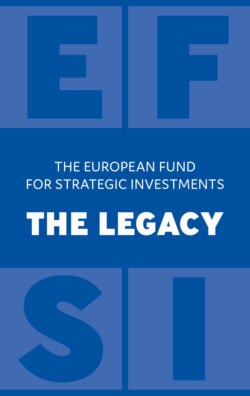Читать книгу The European Fund for Strategic Investments: The Legacy - Группа авторов - Страница 7
На сайте Литреса книга снята с продажи.
ОглавлениеIntroduction
How it started
Inside EFSI: The Managing Director
In autumn 2014, Wilhelm Molterer walked from his office on the top floor of the European Investment Bank’s sloping glass headquarters. He entered a meeting room where he joined the EU bank’s president, Werner Hoyer. A former Austrian finance minister, Molterer was one of the Bank’s eight vice-presidents, overseeing its massive operations in the EU Member States and around the world. He wondered what Hoyer intended, particularly when he saw that the meeting room also contained the Bank’s two most important members of staff, Klaus Trömel, head of lending operations, and Secretary General Alfonso Querejeta.
Hoyer told the trio that he had discussed Europe’s economic situation with Jean-Claude Juncker, the former Luxembourg prime minister who was soon to take over as president of the European Commission. Europe had been buffeted by a financial crisis only a few years earlier and the economy was still in trouble. Investment volumes had plummeted during the crisis and remained far below pre-crisis levels. The banking sector had little risk-bearing capacity. Public budgets were squeezed. There were other concerns about the immaturity of European capital markets and inconsistent regulatory environments across the European Union. In response, Juncker had told Hoyer that he needed to send a strong signal that economic recovery was the new Commission’s priority and that it would put the full power of EU institutions behind the task. Hoyer was ready and had proposed ideas of his own about how the European Investment Bank might respond. He wanted to ally the Commission, which manages the EU’s budget, with the financial machinery and expertise of the EIB, the world’s biggest international financial institution.
Still, the plan was going to take the Bank into unknown territory. Molterer and his colleagues wondered at the challenging nature of the project as they began to put together a structure for it. They also aimed for an ambitiously large amount of investment—€315 billion in supported investment over three and a half years, which would later be increased to €500 billion over two additional years, once the programme had started to prove itself. For the EIB, Molterer saw that this programme would mean a shift from output—making big loans to big projects—to impact, in which every euro it loaned would have to trigger an eventual investment totalling €15, when the funds crowded in from other investors were included. It would be investment on the ground that counted.
Everything had to get rolling quickly, too. The Bank would have to deliver from the very first day after the regulation was in place. It was not an institutional concept. There were no country or sector quotas. The programme would be market-driven. Demand for investment from companies would determine where the new programme would invest. All this had to be done with sufficient transparency to satisfy the European Parliament.
The fundamental principles of what would eventually be the European Fund for Strategic Investments (or EFSI) were quickly in place. The EU budget would offer a guarantee to be used by the EIB Group (the Bank, plus its specialist subsidiary for small businesses, the European Investment Fund) to develop and deploy products for the market. Juncker had made it clear that the Commission was not a bank and that he wanted to leave that end of the plan to the EIB. “This really makes it crystal clear that the plan is a shared responsibility, putting the strengths of the Commission and the Bank together,” Molterer thought.
A critical element would be to maintain a lean governance structure for this new, market-driven initiative. While the EIB would deploy the financial products, there had to be an independent body to decide upon the availability of the guarantee. That would be key to a transparent and trustworthy application of the regulations and their instructions for how the EIB might use the guarantee. Soon, this body came to be known as the Investment Committee. Its operation and the role it took in the €500 billion success of the European Fund for Strategic Investments are the subject of this document. The aim is to get a view from the inside and to expand upon the lessons learned through EFSI and how they might be applied to future economic stimulus programmes in Europe or around the world.
The EFSI Steering Board
In setting up and operating EFSI, the role of the Steering Board was vital. EFSI Managing Director Wilhelm Molterer and Deputy Managing Director Iliyana Tsanova would like to thank the Steering Board, in particular for the insights and guidance of Chairpersons Kerstin Jorna and Gerassimos Thomas and European Investment Bank Vice President Ambroise Fayolle. Molterer and Tsanova add that they are also deeply grateful for the dedication of the staff of the European Investment Bank and European Investment Fund and for the work of the EFSI Secretariat.
